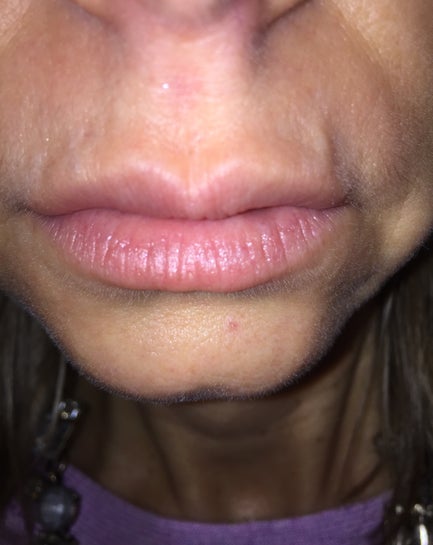Broken Blood Vessel In Lip

A broken blood vessel in the lip, also known as a lip hemangioma or lip telangiectasia, can be a concerning and often painful condition. It occurs when a small blood vessel in the lip becomes damaged, leading to bleeding and the formation of a small, red or purple spot. In some cases, the broken blood vessel can cause swelling, bruising, and discomfort.
Causes of Broken Blood Vessels in the Lip
There are several possible causes of broken blood vessels in the lip, including:
- Trauma: A blow to the lip or mouth can cause a blood vessel to rupture, leading to bleeding and bruising.
- Injury: Cuts, bites, or other injuries to the lip can damage blood vessels and cause them to break.
- Surgery: Lip surgery, such as a lip lift or lip augmentation, can cause blood vessels to become damaged and lead to broken blood vessels.
- Infections: Certain infections, such as cold sores or canker sores, can cause inflammation and damage to blood vessels in the lip.
- Aging: As we age, our blood vessels become more fragile and prone to breaking, which can lead to broken blood vessels in the lip.
- Sun exposure: Prolonged exposure to the sun can cause blood vessels in the lip to become damaged and lead to broken blood vessels.
Symptoms of Broken Blood Vessels in the Lip
The symptoms of a broken blood vessel in the lip can vary depending on the severity of the condition. Common symptoms include:
- Red or purple spot: A small, red or purple spot may appear on the lip, which can be tender to the touch.
- Swelling: The lip may become swollen and inflamed, especially if the broken blood vessel is large or in a sensitive area.
- Bruising: Bruising may occur around the affected area, which can be painful and unsightly.
- Pain: A broken blood vessel in the lip can be painful, especially if it is touched or pressed.
- Bleeding: In some cases, the broken blood vessel may bleed, which can be alarming and require medical attention.
Treatment Options for Broken Blood Vessels in the Lip
Treatment for a broken blood vessel in the lip depends on the severity of the condition and the underlying cause. In some cases, the condition may resolve on its own with time and self-care. However, if the condition is severe or persistent, medical treatment may be necessary.
- Self-care: Applying ice to the affected area, avoiding spicy or acidic foods, and using a topical cream or ointment to reduce inflammation and promote healing.
- Medications: Over-the-counter pain relievers, such as acetaminophen or ibuprofen, can help to reduce pain and inflammation.
- Laser treatment: Laser therapy can be used to close the broken blood vessel and reduce the appearance of the affected area.
- Sclerotherapy: A solution is injected into the broken blood vessel to close it off and reduce its appearance.
- Surgery: In severe cases, surgery may be necessary to remove the affected blood vessel and repair any damage to the surrounding tissue.
Prevention of Broken Blood Vessels in the Lip
While it may not be possible to completely prevent broken blood vessels in the lip, there are several steps that can be taken to reduce the risk:
- Avoid trauma: Avoid activities that can cause trauma to the lip, such as contact sports or roughhousing.
- Protect the lip: Wear protective gear, such as a mouthguard, when engaging in activities that can cause trauma to the lip.
- Avoid excessive sun exposure: Wear sunscreen and a hat to protect the lip from excessive sun exposure.
- Don’t smoke: Smoking can cause blood vessels to become fragile and prone to breaking.
- Maintain good oral health: Practicing good oral hygiene and visiting the dentist regularly can help to prevent infections and reduce the risk of broken blood vessels in the lip.
- Persistent or severe pain
- Increased swelling or bruising
- Bleeding that doesn't stop after 10-15 minutes of pressure
- Fever or chills
- Increased redness or warmth around the affected area
What causes a broken blood vessel in the lip?
+A broken blood vessel in the lip can be caused by trauma, injury, surgery, infections, aging, or sun exposure.
How long does it take for a broken blood vessel in the lip to heal?
+The healing time for a broken blood vessel in the lip can vary depending on the severity of the condition and the effectiveness of treatment. In some cases, the condition may resolve on its own within a few days, while in other cases, it may take several weeks or even months to heal.
Can a broken blood vessel in the lip be prevented?
+While it may not be possible to completely prevent broken blood vessels in the lip, there are several steps that can be taken to reduce the risk, such as avoiding trauma, protecting the lip, avoiding excessive sun exposure, not smoking, and maintaining good oral health.
In conclusion, a broken blood vessel in the lip can be a concerning and often painful condition. However, with proper treatment and self-care, it is possible to reduce the appearance of the affected area and promote healing. By understanding the causes, symptoms, and treatment options for broken blood vessels in the lip, individuals can take steps to reduce their risk and seek medical attention if necessary.


